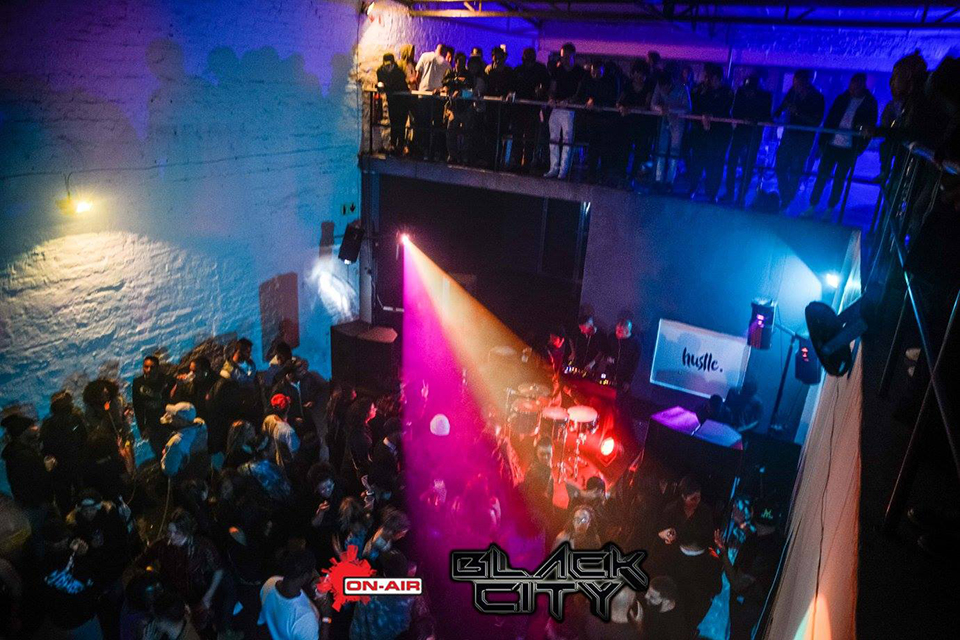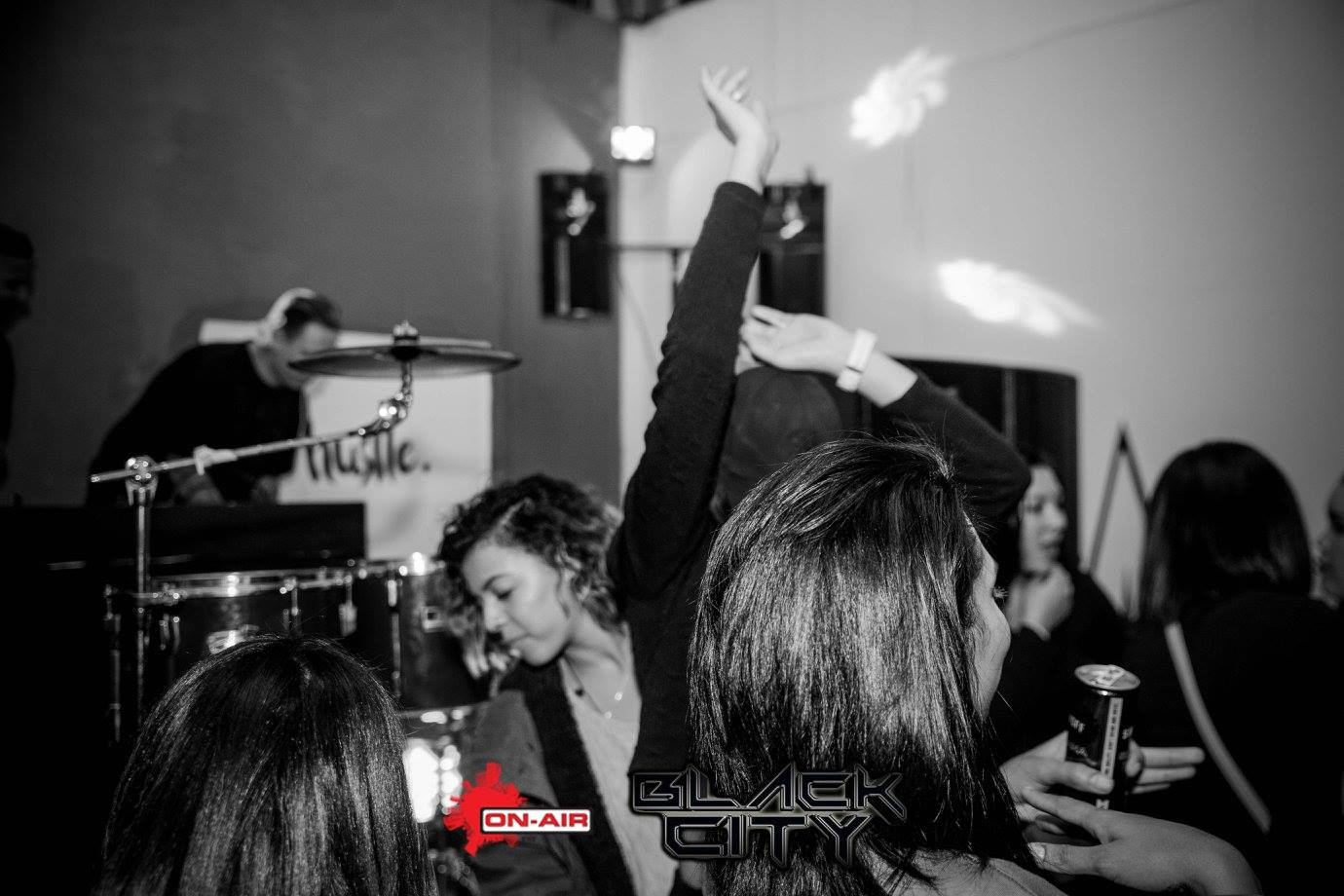Nyctaphobia: a fear of the night or darkness.
Night fright permeates many conventional imaginings of the city, as the dark plays host to a web of seedy associations: violence, criminality, backwardness. Illumination, on the other hand, connotes a glistening cityscape. We envision a technologically-enhanced wonderland that is safe, accessible, and bustling with consumer activity. The delivery of light to South Africa’s ‘dark corners’ has at different times highlighted both the successes and failures of democratic modernity. Since the late 2000s, the country has experienced a series of rolling blackouts, dubbed ‘load shedding’, plunging millions of residents into new encounters with the dark.
In 2010, one such urban eclipse gave way to a series of after-dark parties in Johannesburg. Dubbed Black City, these parties have sought to re-imagine and revitalise audiences’ relationships with the dark, and indeed the city. A blackout. An interruption. A disruption of traditional patterns of moving, thinking and relating.
This week, I sat down with two of the parties’ masterminds. Cardo is an events entrepreneur/promoter. Imtiyaaz is primarly a DJ, and one half of the duo Problem Kids (otherwise known as PK Musiq). As DJs-come-promoters, Problem Kids co-host night-time events, including Juice and Black City.
‘With load shedding at its peak’, Cardo explained, ‘I found myself staring at a beautiful city in darkness. Moulded in that darkness a phenomenon was born: Black City’. The first Black City curated a nightclub stripped of its colour, where both audience and venue were embalmed in black fabric. All black dress code. All black décor. ‘Six years ago, I don’t think black was what it is now. There was no All Black Movement at that time. Everybody only knew All White parties. That was the craze.’
The inspiration behind ‘all black’, Cardo explained, drew from street fashion. The rising popularity of black monochrome increasingly matched people and pavement, giving way to a tacit aesthetic consenses and a statement of collective identity. Today, the predominance of all black monochrome cannot be delinked from a wider revival of Black Consciousness politics, of Black Power, of Black is Beautiful. In South Africa, a history of imposed curfews for black residents provides centuries of impetus to take back the dark and the city.
The switching on of nightclub lights at closing time has visceral affect. Under the everyday glare of a 60 watt bulb, we see each other in all our ordinariness, stripped of the fantasy, subsumed by sudden awkwardness. Without the darkness, all the intimacies we made between us coming undone. After all, it is in the dark that we dream. Nightcover beckons the creativity of grafitti artists, the insurgency of activists. In this case, it also offers a stage for the subtle politics of urban partying.
What Black City sought to harness were the productive and imaginative qualities of darkness — so often neglected. They understood that even the brilliance of light relied on a depth of darkness. On one occasion, Black City filled the darkened nightclub with UV lights. Add neon paint and something spectacular explodes onto the scene.

Saturday night (28th of May) was the 10th and final Black City installment, coinciding serendipitously with government’s recent announcement that loadshedding had come to an end. Black City parties have circled from the Centre to the North and back again: Newtown > Rivonia> Fourways > Sandton > back to Newtown.
As an audience member, Black City launched me onto an experimental fence between inside and outside, the seen and the unseen, the raw and the produced. It transposed outside darkness into an inside space: this time, Antidote, in Newtown. Antidote does not announce itself on its outside walls. One has to enter before spotting the signage. This inabiliy to immediately ‘recognise’ Antidote is, paradoxically, the very source of its recognition as a trending hotspot. While the dancefloor is relatively small, the walls encircling it seem to stretch up for kilometers with a VIP audience lining the four-walled balconies above. Borromean rings interlocking the circles of dancers, hookah smokers, and smoke itself. The height of the room simulated being in a pit, animating the affect of the ‘underground’.
Around midnight on Saturday, Problem Kids emerged on stage, announcing themselves with a soundtrack of percussive house. They were soon joined by a live drummer, pounding the snare and symbols to accent the sounds from the decks. His drumsticks drove the house beat forward and charged it through its audience. Dark heightens the non-visual senses: sound, touch, taste. The juxtaposition of snare and soundsystem brought the crowd into close confrontation with the music. At times, the sound was so proximate that it might have emerged from our own bodies, as though our very movement made it.
It was during a gig in Klerksdorp that the drummer first appeared on stage with Problem Kids. ‘We told him to come with’ Imtiyaaz explained. ‘The crowd went mad, so we brought it [the act] back to Jo’burg’.
By cultivating sonic conversations between the metropalis and smaller towns, Problem Kids foster an inside-outside dialectic. They bring the city to town, and the town to the city.
‘We branched out’ Imtiyaaz explained. ‘We got into Bloemfontein. We got into Kimberley. A whole lot of places outside of the city. It actually pumps there. Nothing happens in those places, so when something does happen, everyone is there’.
This inside-outside dialectic is repeated in performance. As PK Musiq manipulate the decks, they keep one ear to a stick-headphone they call ‘the lepel’ (spoon), and another to the room. ‘I can’t play with headphones anymore’, says Imtiyaaz, ‘I wanna hear.’
For most of the world’s working population, daytime is a time of discipline – of regulation and traffic, schedules and tasks. As dark falls, there is an exodus of commuters escaping the city, pulling at their shirt collars. But many forget the counter-exodus: those who travel inwards at night. This ‘second city’ has its own geography, its own citizenry. Here, the young rule. They are the buyers and the sellers; the curators and the artists; the performers and the audiences; the celebrities and the fans; the rulers and the followers; the gatekeepers. At night, Problem Kids become Kings.
The young brains behind Black City told me their parents did not approve at first. ‘My mom was against the whole nightlife thing’, Cardo explained, ‘But after a while she saw the dedication and the hard work I put in and she understood it’. Imtiyaaz’ parents are similarly resigned: ‘Oh well, he’s surviving on what he does, so it must be good’. This was about proving that the night was an industry, in which they were at the top of both their – and the – game!
Cardo and Imtiyaaz explain that their industry functioned because, unlike in Cape Town, Johannesburg’s nocturnal inhabitants are willing to spend. Otherwise, ‘How are you gonna pay your artists? How are you gonna pay your venue?’
For Imtiyaaz and Cardo, the money was a surface reflection of another tacit currency being circulated between audiences and performers. This was an economy of recognition.
Their own night-time success relied on sustaining a loyal following. ‘People are still messaging me about Black City. I basically love events for that. The thank you messages: ‘Black City was such a blast’. As part of this crowd-cultivation, the Black City crew come to know their audience intimately. Aware, for example, that many of their followers observe Ramadan, some online marketers promoted the party as ‘The Blast Before the Fast’. Indeed, Johannesburg’s young coloured population — so often invisible in the urban cartography — are a noticeable contingent among Black City followers.
For audiences, the politics of nightclub recognition has another expression, and that is in the will to ‘be seen’.
‘People don’t go out anymore to have a good time, like they used to. It’s more about the fashion. They want to be seen…. ‘
Black City’s creators spoke of something double-edged about the colour black.
‘You can either hide, like there’s something mysterious about you. Or you can express yourself wearing All Black’.

Notably, instead of causing people to disappear, an All Black theme encouraged partygoers to dress up, offering opportunities to ‘be seen’. ‘Jo’burg knows how to sell cool’, Cardo and Imtiyaaz explained. Popping bottles, the fashion, the lifestyle, all of it is about being seen. It’s recognition, I’m told, that many partygoers vehemently pursue, sometimes with significant stakes.
People come to be photographed. ‘We just released the pics from ‘Black City’, which regenerated the hype again.’ Recognising the significance of nightclubs as backdrops, Black City has incorporated photobooths from its inception, prefiguring an Instagram generation. Posted online, scrolls of pictures from a dark room, emblazoned with the tagline ‘last night was lit’.
Instead of viewing this urge for visibility as narcissistic mania or dystopian materialism, we might also consider how recognition functions as a vital human need. A politics of recognition is about claiming space and power: projecting oneself outward into the world and leaving a trace.
In 1983, Kim Gordon of the band Sonic Youth, made an observation about the economy of nightclub culture. She said, ‘people pay to see others believe in themselves’. Through this simple sentence, Gordon sketched a diagram of intersubjectivity in the nightclub, mapping the relational pulls and conflations between audience and performer. Among Johannesburg’s millennial clubbers, we might say this: People pay to believe that others see them.
Ironically, this visibility happens in the dark, through the dark, because of the dark.



















































